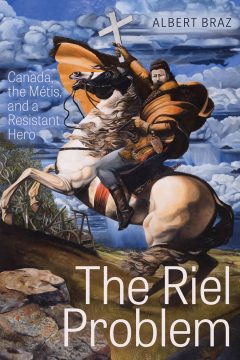Historical figures are ready props in any political argument. They are dead and in no position to complain. But this cuts both ways. Historical facts are set in stone: names, dates, embarrassing diary entries. Public figures who invoke history to justify a political impulse are taking a chance, which brings us to The Riel Problem. This is not another book about Louis Riel. It is much better.
In my Manitoba school days Riel was given short treatment as a messianic rebel leader who maybe didn’t deserve to be hanged for treason. The first public speech I heard in praise of Riel as a national icon was not by any Manitoba MLA but a Bloc Québécois MP, in Ottawa, in 1993. Today he is “a Franco Catholic martyr,” “an Indigenous hero,” “a Father of Confederation,” writes Albert Braz, Professor Emeritus at the University of Alberta’s Literature and English department.
Riel has inspired countless novels and screenplays. The iconography is mainly government-sponsored. Riel is not a folk hero but a prescribed Official Hero once called “Martin Luther King a hundred years before Martin Luther King.”
“By 2010 even such an eminent figure as the then-Chief Justice of the Supreme Court of Canada, Beverley McLachlin, could declare that ‘Riel fought against Canada in the name of values that Canada now proudly embraces,’” writes Professor Braz.
Ex-Senator Murray Sinclair (Man.), chair of the 2015 Truth and Reconciliation Commission, recited Riel’s best known quote: “My people will sleep for 100 years but when they awake it will be the artists who bring back their culture.” Problem: There is no evidence Riel ever uttered the phrase.
“There may be a discrepancy between the way the Canadian cultural and political elites perceive Riel and the way the general population does, evidenced by the ‘troubling’ online comments that tend to follow pro-Riel interventions,” notes the author. As Braz puts it, “A country’s conversion of a former enemy into a national icon is never innocent.”
There lies The Riel Problem. Braz documents why this charismatic and peculiar man became “the epitome of Canadianness.” His work is wry, engaging and good-humoured. It is a first-rate account not merely of Louis Riel but of his caricature as a political prop.
The bare facts are known: Riel was born in what is now Winnipeg in 1844 and executed in Regina in 1885. In between he studied for the priesthood, worked as a schoolteacher, was twice institutionalized for mental health, became President of the Red River Provisional Government and “has emerged as nothing less than the quintessential Canadian hero.”
Riel also took out U.S. citizenship, called himself “an American” and petitioned then-President Grover Cleveland to annex Manitoba. Riel described Confederation as an “immense fraud” and hatched a scheme to have Irish Catholics emigrate from Boston and New York to Winnipeg and build “a province of their own” with French Catholics.
“He embraced the United States as the defender of the Métis,” notes Braz. And those ancestral First Nations lands? They “belonged to France,” wrote Riel. As The Riel Problem explains, “Riel is an immensely complex but contradictory figure.”
Why the novels and screenplays and Supreme Court tributes? Because Riel “embodies some of the country’s great divides” that remain politically vexing, writes Professor Braz: “French and English, East and West and Indigenous and non-Indigenous.” He was the whole package.
“Why are we so invested in Riel?” asks Braz. “In light of the mid-twentieth century turn to the nation and away from empire, it is not surprising that Canadians would search for heroes deeply grounded in the national space. But this could include almost any Indigenous historical figures.”
Riel 139 years after his death remains politically useful. The Riel Problem is honest and compelling.
By Holly Doan
The Riel Problem: Canada, The Métis And A Resistant Hero, by Albert Braz; University of Alberta Press; 344 pages; ISBN 9781-77212-7348; $34.99






